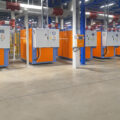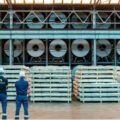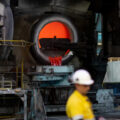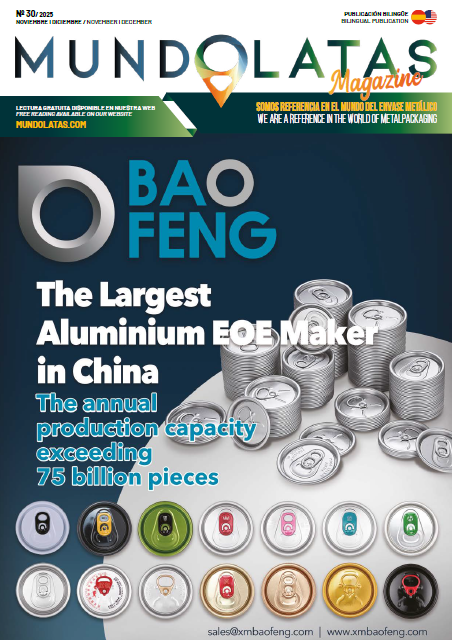In any two-piece can factory, most of the electrical consumption—and therefore, most of the energy bill—comes from air compressors and vacuum pumps. These two services dominate energy consumption, making them the most critical to monitor and optimize.
At recent can industry events in Europe—the CanMaker Conference (Barcelona, November 2024) and the CanTech Grand Tour (Brussels, April 2025)—participants heard a compelling presentation from Ms. K. Kazaschka, executive director of Metal Packaging Europe (MPE). She presented the EU Clean Industry Agreement and explained how it supports the broader Green Deal, which aims to transform the European economy into a climate-neutral and resource-efficient system by 2025.
This makes analyzing CO₂ emissions per kilowatt-hour (kWh) in can production not only practical but urgent. Reducing energy consumption decreases both costs and environmental impact. Given the high energy requirement of pneumatic equipment, it is essential to accurately assess its long-term efficiency.
Choosing the Right Equipment
Among the many global manufacturers of compressors and vacuum pumps, only a few demonstrate a genuine commitment to environmental responsibility. These companies design machines with lasting energy efficiency and offer extended warranties—some up to 10 years—not just for performance, but for efficiency itself.
Durability, Performance, and Efficiency: Fundamental Concepts
Durability is measured over time; energy efficiency, however, is not time-dependent. Product catalogs and standard legal warranties, often limited to one or two years, offer little long-term security. Although a machine’s performance may seem constant over time, the crucial question remains: Does it maintain the same energy efficiency it had at the time of installation?
In the current industrial context—where sustainability is not only an environmental priority but also a social one—manufacturers must adopt a responsible approach. In this article, we focus on a key environmental indicator: CO₂ emissions, one of the main drivers of global warming.
One of the most effective strategies to reduce CO₂ emissions is to minimize energy consumption. For high-energy-demand equipment, such as compressors and vacuum pumps, long-term energy efficiency is essential to keep electricity use proportional to production capacity. The environmental urgency is not new. As early as the late 20th century, scientists issued serious warnings about the global ecological imbalance. Given that the Earth is 4.5 billion years old, it is shocking that only 200 years of industrial civilization have substantially altered the planet’s climate. With a human life expectancy of around 80 years, this burden of responsibility falls solely on recent generations.
A Legacy of Engineering Excellence
The name Pneumofore, derived from ancient Greek—pneuma (air) and phoros (carrier)—reflects the company’s identity. Since its founding in 1923 by Swiss engineers, Pneumofore has remained true to its focus on rotary vane technology for industrial vacuum pumps and air compressors.
Unlike its diversified competitors, Pneumofore’s commitment to a single technology has allowed for deep specialization, and with it, the confidence to offer a 10-year warranty on energy efficiency. The performance evaluation of vacuum pumps and compressors depends on the relationship between absorbed power (kW or hp) and output capacity (m³/h or cfm). If this relationship remains stable, efficiency is maintained. If energy consumption increases while production remains the same, energy efficiency has decreased, often indicating the need to refurbish the pumping unit, the core of the machine. This decrease in energy efficiency increases both CO₂ emissions and electricity costs for the customer.
CO₂ and Global Temperature
Reducing CO₂ emissions is more than an ethical goal: it’s a scientifically-based imperative. Agencies across Europe¹ and the United States² continue to monitor global temperatures. An increase of 1.5°C—already a recorded reality—carries severe consequences: loss of biodiversity, polar ice melting, extreme weather events (floods, hurricanes, droughts), and greater health risks associated with air pollution.
The Relationship Between kWh and CO₂
Public data shows that, on average, 1 kWh of electricity consumed equals 0.5 kg of CO₂ emissions, although in some global estimates this figure reaches 1 kg/kWh. For example, according to the UK Government’s Greenhouse Gas Reporting Conversion Factors (2023), the carbon factor is 0.207 kg of CO₂ per kWh. The industry in the UK is incentivized to reduce emissions, receiving £64.90 per ton of CO₂ saved—or approximately €78 for every 1,000 kg of CO₂, which is equivalent to a reduction of 2,700 kWh.
It’s worth noting that emission conversion data often lags behind industrial development due to political and regulatory complexity, especially within the 27-member European Union, where harmonization and updates are slower to implement.
kWh and Cost: A Global Comparison
Electricity prices vary worldwide, largely depending on production methods. For comparison:
- China: €0.08/kWh
- France: €0.16/kWh
- Germany: €0.23/kWh
- Italy: €0.30/kWh
- United Kingdom: €0.39/kWh
It’s clear that energy efficiency is not just an ecological imperative, but also an economic advantage.
In a market where Asian manufacturers benefit from lower labor costs, European producers must invest heavily in R and engineering quality to remain competitive.














